Last Updated on September 21, 2025 by Ewen Finser
Shipping is absolutely, utterly, completely, with shrieking boldface and capital letters central to e-commerce. And while Shopify Shipping offers you great rates with the major carriers, embedded insurance of up to $200 on every shipment, and better rates when shipping via DHL, a lot can go wrong as your store scales.
New geographic areas mean fulfillment complexity. A wider product range means specialized carriers. Then there’s today’s shoppers need, no, insistence on customized post-purchase experiences.
If you want to make an informed decision on what third-party shipping platform you should consider to replace Shopify Shipping — plus the kind of results you should expect — this guide can help.
We did the digging, substantiating, and verifying for you.
When Shopify Shipping Isn’t Enough
Shopify’s native service is a great starter kit for domestic, low-volume operators. But as your business develops, you’ll outgrow it fast, most likely because of one of the following reasons:
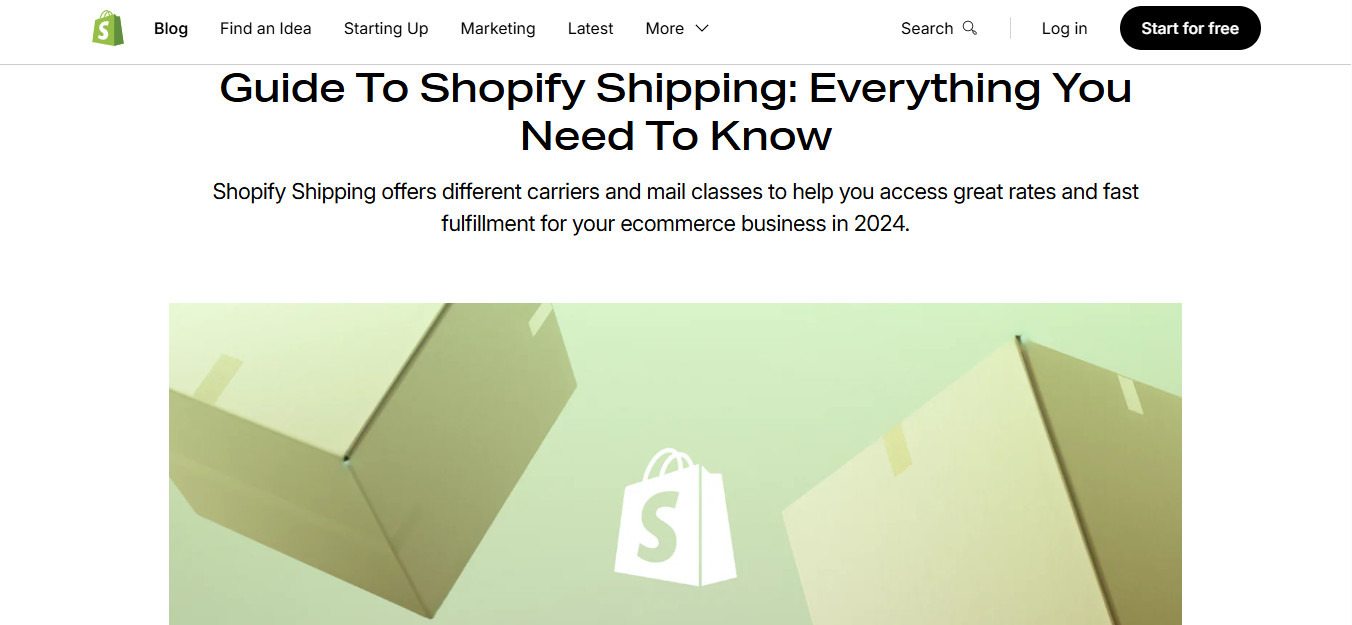
- International Complexity: Real-time duties, tax calculations, IOSS compliance, and DDP options are needed for cross-border sales. Shopify Shipping doesn’t handle imported paperwork or landed cost transparently, leaving vendors to cobble together manual workarounds that frustrate customers.
- Automation: At 10 orders a day, a manual rate check is fine. At 500 orders a day, you need rules like “route any order over 10 lbs via FedEx Ground” or “auto-select 2-day on all orders above $200.” Without that, you burn hours on repetitive tasks and risk potentially store-wrecking human errors.
- Cost Flexibility: As your store grows, you often need volume discounts, batch label processing, and enterprise shipping contracts that Shopify Shipping can’t offer.
- Brand Experience: Branded packing slips, tracking pages, notification emails, and similar tools shape perception and build customer loyalty. Limited customization means Shopify-native setups can feel generic, and you miss opportunities to differentiate.
- 3PL Partnerships: When warehousing, returns management, and labeling turn into full-time jobs, you need a partner that can handle everything from shelf to doorstep. Plugging in a third-party logistics provider simplifies scaling on speed and geography.
If any of these pain points resonate with your situation, it’s time to look beyond Shopify’s built-in tool and embrace a purpose-built shipping platform.
How Did We Decide Who Would Make the List?
We considered the following:
- Carrier Coverage: Number of domestic, international, and regional carriers; access to dynamic rate shopping and availability of special item carriers.
- Pricing Model: Pay-per-label versus tiered subscriptions, hidden fees, volume discounts.
- Automation & Rules: Granularity in routing, service-level assignments, packaging, returns workflows.
- Integrations: Depth of Shopify, marketplace, ERP, CRM, WMS, and custom API connectivity.
- Ease of Use: Onboarding time, friction in daily use, quality of support and documentation.
- Advanced Features: Branded tracking, customs paperwork automation, shipment insurance, manifests, and pick-and-pack orchestration.
- Scalability: Suitability across low-volume startups through enterprise operations, including predictable cost scaling.
These criteria aren’t isolated. Broad carrier choice plus flexible pricing optimizes cost. Robust automation fuels growth without hiring extra staff. Deep integrations prevent data silos. Advanced features increase customer loyalty.
So, let’s begin.
#1. Shippo: The Sweet Spot for Almost Every Vendor
Shippo is a cloud-based, multi-carrier shipping platform that simplifies order fulfillment for merchants ranging from solo sellers to growing mid-sized brands. It easily integrates with a number of selling platforms, besides Shopify.
It connects to over 40+ carriers—including USPS, UPS, FedEx, DHL Express, and regional specialists. This allows Shippo to aggregate volumes and deliver rates previously reserved for big brands.
I personally love the search function to locate these regional players:
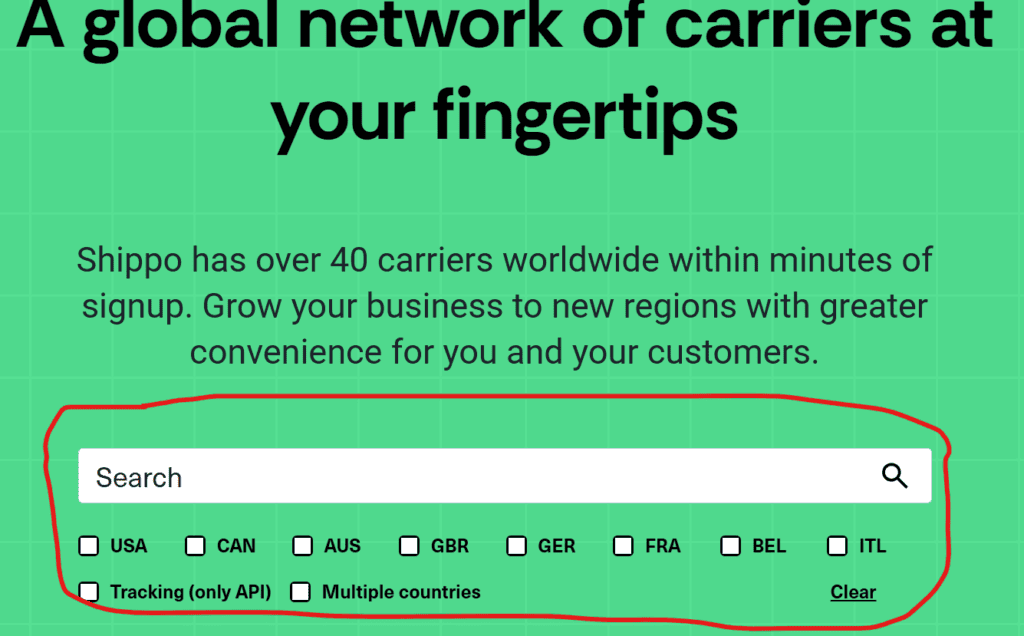
You can generate both single and batch labels in multiple formats (PDF, ZPL, DYMO), and create manifests for streamlined carrier scanning.
A developer-friendly API and SDKs enable integrations with custom apps, ERPs, or 3PL systems, while an address validation system and one-click insurance on single package shipments help reduce delivery errors and protect parcels against loss or damage.
Trusted by over 100,000 vendors, Shippo offers a flexible, usage-based pricing model that scales from a side hustle to a high-volume business.
The free Starter plan gives you enough flexibility that you can test your ideas risk free.
As volume grows, Professional tiers ($19–$199 per month) unlock phone support and multi-user seats.

What I Love About Shippo

The best part of Shippo is early-stage ventures and small vendors avoid hefty fixed fees yet still enjoy discounted postage and features that matter. They also get:
- Unified Rate Shopping: See all carriers in one view to pick the best mix of cost and speed.
- Access to Top Carriers and Discounted Shipping Rates: Shippo merchants can access discounted rates, up to 90% off retail with FedEx, USPS, and UPS simply by signing up. You also have the option to connect dozens of other carrier accounts to the platform, ensuring you always have the best carrier mix for your business.
- Supports Dropshipping: If you use a dropshipping partner or ship directly from the manufacturer, Shippo allows you to buy and send labels with a different “ship from” address to the dropshipping company.
- CSV Upload Support: Batch process your orders via CSV uploads, a time saver for sellers who manage orders from multiple sources.
- Branded Tracking & Notifications: Customizable tracking pages and email updates keep your brand front and center.
- Multi-Store Management: Manage orders and create labels for all your stores—not just Shopify—from one dashboard.
- Rule-Based Automation: Assign carriers, packaging templates, and service levels based on weight, destination, or order value.
All told, Shippo balances functionality and affordability.
#2. ShipStation
When your brand operates at scale and you sell across different selling platforms, ShipStation stands out for high-speed, rule-driven workflows that comfortably handle such complexity.
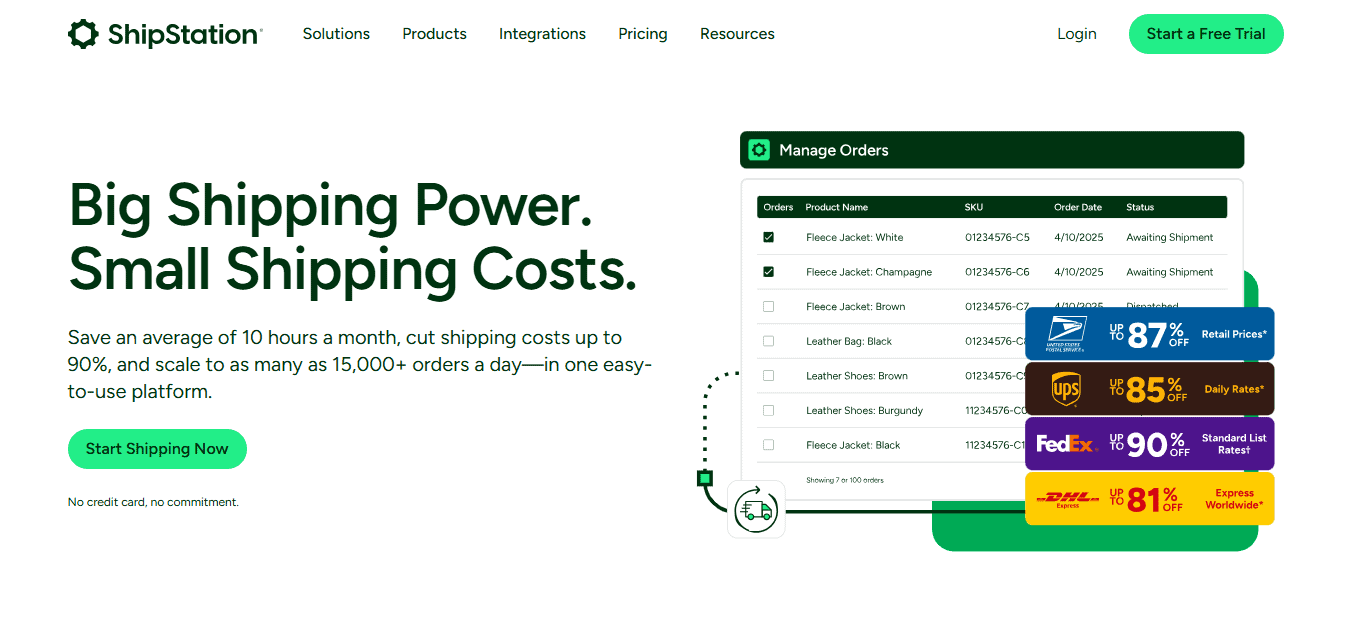
Its subscription tiers range from $14.99 per month for 50 shipments to custom-priced Enterprise plans. In exchange for a flat fee, you get advanced automation: carrier, service level, package type, insurance selection, and more, all triggered by conditions you define.
Batch label printing, packing slips, returns portals, and deep reporting across shipping spend, carrier performance, inventory velocity, and profitability combine to make it an all-in-one store operations cockpit.
ShipStation integrates with over 400 platforms, everything from major marketplaces to ERP, CRM, and WMS systems, plus mobile barcode scanning, forecasting tools, and purchase-order functionality.
Customizable labels, branded tracking pages, and email notifications also help reinforce your brand at every touchpoint.
But be aware, because power comes at a price, and ShipStation’s recent pricing overhaul kicked off a backlash all over the Internet.
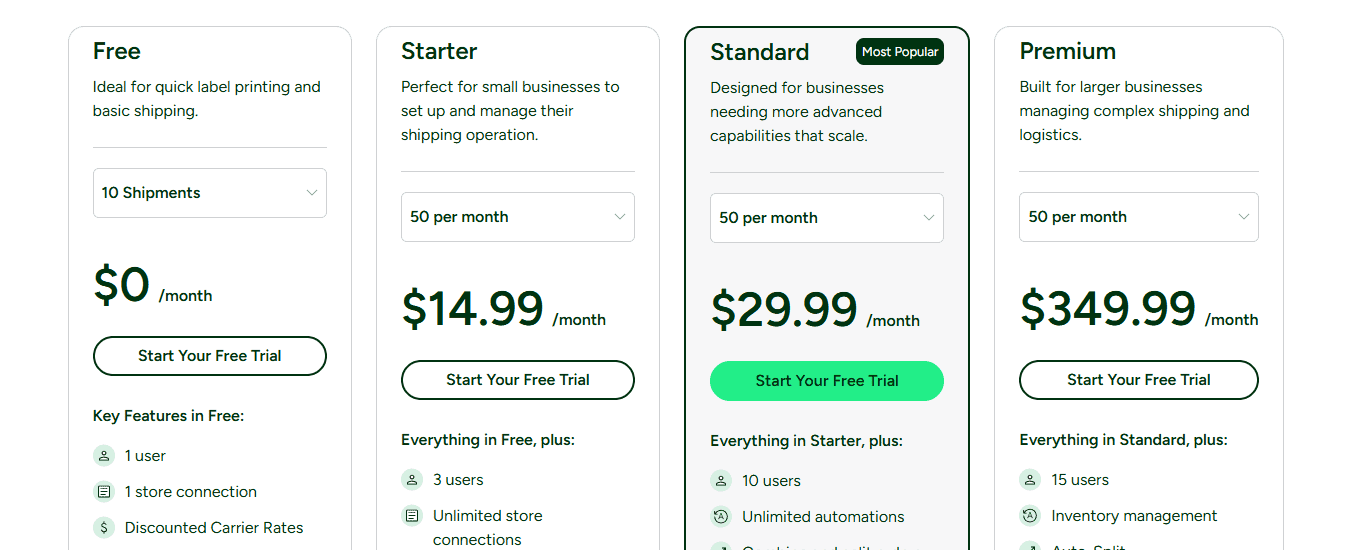
API access, once included in lower-tier plans, was relegated to the more expensive tiers. Change came with little notice and no clear rationale, compelling API-reliant vendors to either triple their fees or migrate platforms. All these sparked outrage on Reddit and elsewhere.
Users decried the move as bait-and-switch, undermining trust in what had been a rock-solid partner. Furthermore, most complaints from the vendors never received any response, or they had to wait for weeks. For basically the same thing, some vendors had their increased costs waived by Shipstation, and the others didn’t, fueling backlash for discriminatory practices.
Before you decide: if you process 500+ orders a month across multiple channels and can absorb the sometimes-changing subscription cost, ShipStation’s automation pedigree is solid. Just beware sudden policy shifts that can upend your budget and workflows.
#3. Easyship
For brands going after international markets, Easyship is great at turning cross-border logistics into a unified, transparent experience. It plugs into Shopify checkout with dynamic rates that include duties and taxes, eliminating last-mile sticker shock.

At pricing tiers from free (50 shipments per month) up to $99 per month (5000 shipments) and custom enterprise plans, Easyship automates customs forms, HS code classification, IOSS requirements for EU orders and offers both DDU and DDP options.
Its carrier network spans 250+ carriers, including the usual giants like UPS, DHL, FedEx, Aramex, YunExpress, and regional specialists. This enables vendors to split inventory across fulfillment hubs to cut transit times. A branded tracking portal, automatic notifications, and returns label support keep the post-purchase journey on brand.
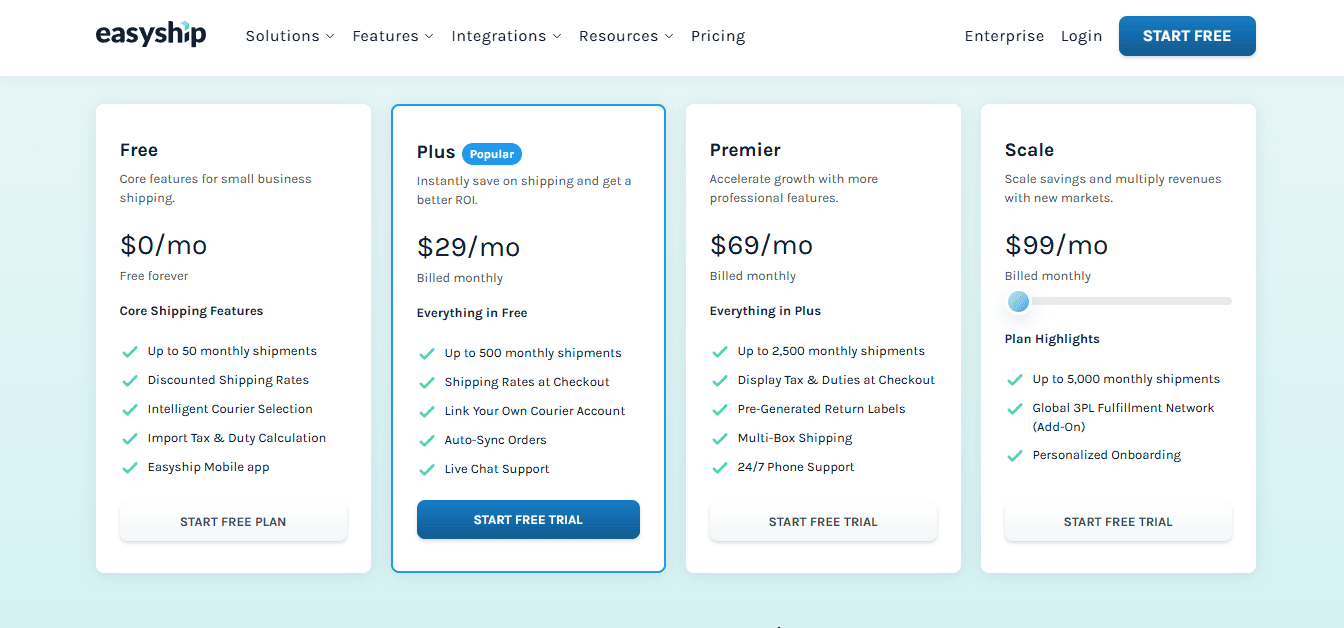
Yet international competence comes with caveats. Numerous reviews highlight slow or unresponsive customer support when critical shipping problems arise. Worse, some vendors report significant billing “adjustments” weeks or months after shipments, hitting their credit cards unexpectedly. For businesses budgeting tight margins, surprise fees can erode any efficiency gains.
Before you decide: Easyship excels if you need end-to-end customs compliance and total landed cost transparency. Just build in contingencies for customer-service delays and watch your statements for stealth adjustments.
#4. Pirate Ship
Like other alternatives here, Pirate Ship aggregates all its users’ volumes to secure commercial-rate discounts and pass them directly to vendors, sometimes as much as 80% off standard USPS and UPS retail pricing.
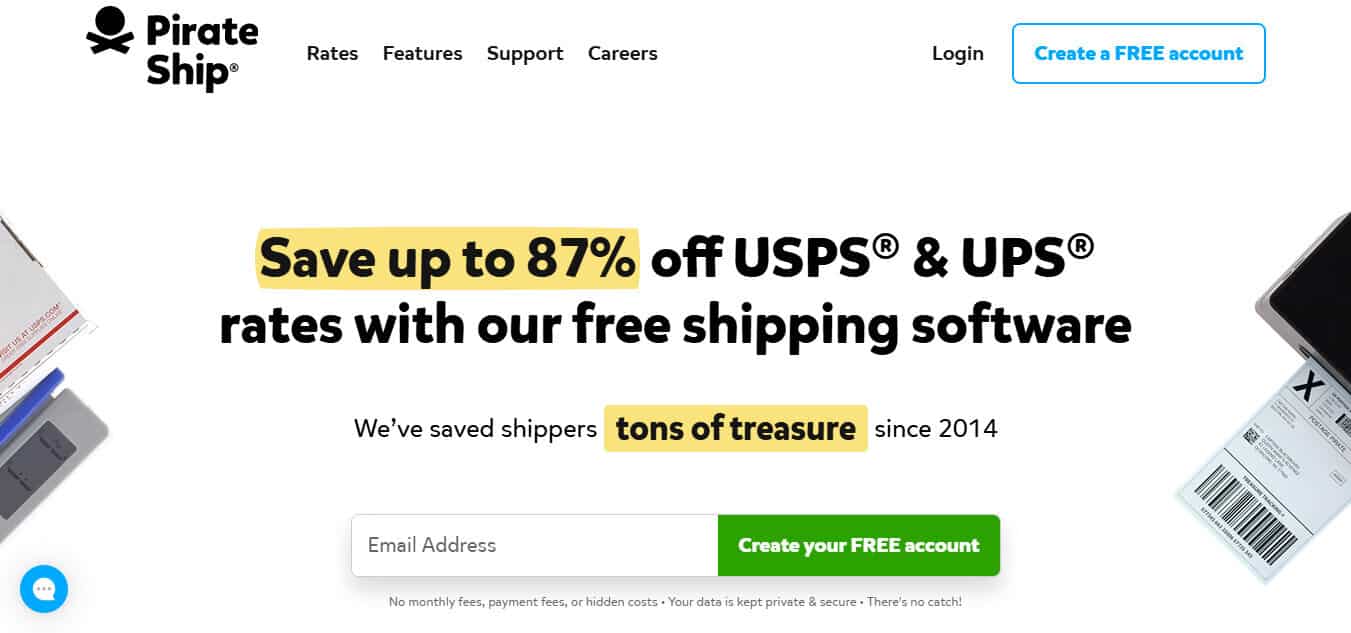
There are no monthly fees, no per-label software charges, no minimums, no commitments. You simply pay postage at deeply discounted rates, plus optional add-ons like address validation.
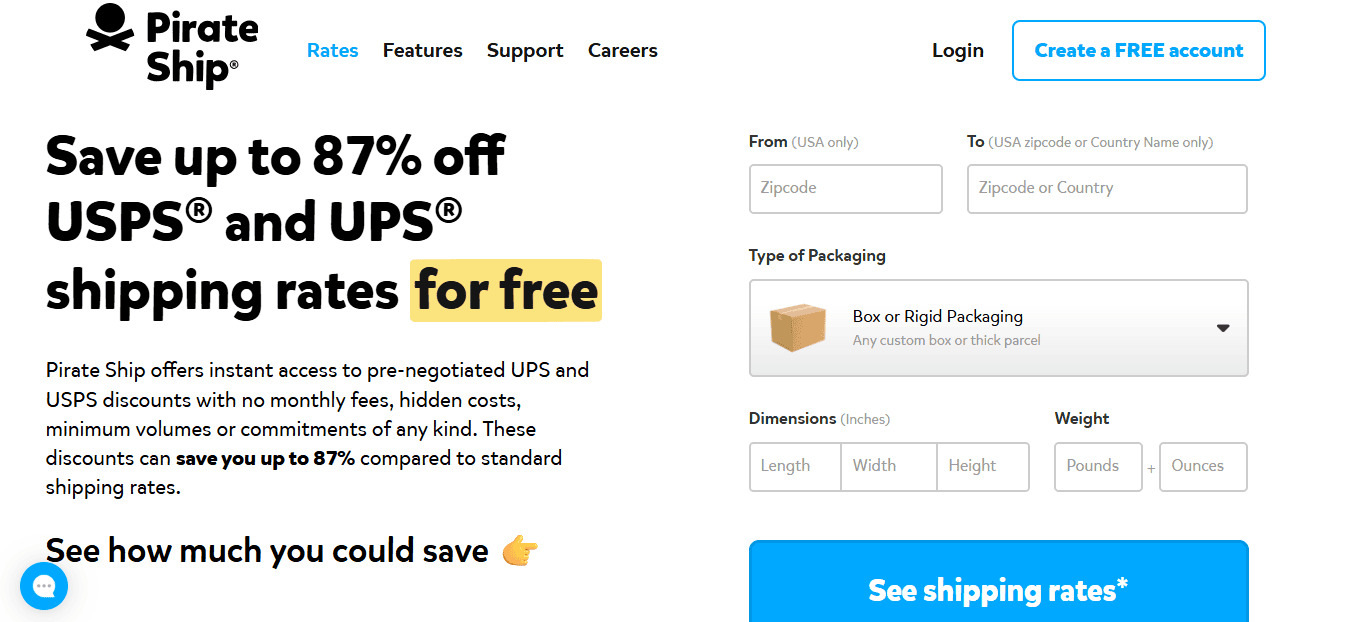
Special features, folded into a streamlined interface, include automatic cubic vs. weight-based rate comparison for USPS Ground Advantage, batch label printing via CSV or Shopify import, and even a simplified international USPS offering for micro-vendors dipping toes in cross-border sales.
It’s the ideal low-volume solution for vendors shipping under 50 packages a month, where every penny saved on postage goes back into marketing, inventory, or product development.
But Pirate Ship isn’t perfect.
Before you decide: Users occasionally report slow label generation under peak loads. A handful of vendors also note unannounced changes to billing practices, leading to confusion and unexpected charges. While the free-forever model is compelling, unpredictable quirks can disrupt a lean operation.
#5. ShippingEasy
ShippingEasy stakes its claim by fusing discounted postage with basic automated email marketing campaigns triggered by shipping events. Plans start with a free tier for 25 shipments per month and scale to $119.99 per month for as much as 6,000 shipments. Integrations cover USPS, UPS, DHL, and FedEx, with proprietary cubic-rate options that sometimes beat commercial-plus pricing.
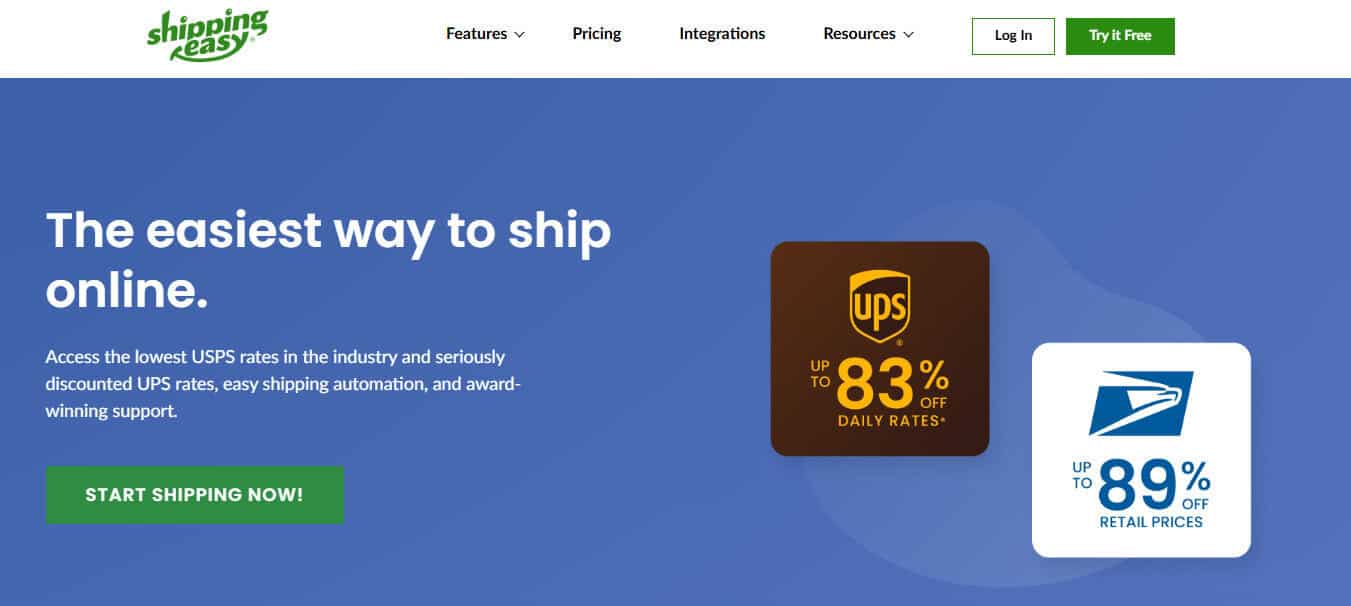
Beyond shipping rules and rate comparisons, ShippingEasy delivers:
- Automated Email Sequences: Abandoned cart reminders, review requests, upsell offers.
- Drag-and-Drop Templates: Pre-built marketing emails you can brand in minutes.
- Customer Segmentation: Targeted messaging based on purchase behavior, demographics, or fulfillment events.
In theory, coupling fulfillment and post-purchase marketing under one roof improves your store operations and increases the opportunity for upsells.
But numerous vendors gripe about unstable service. Reports cite sudden account closures without explanation and persistent software bugs. Add in inventory auto-adds, two-factor authentication failures, and things start to get messy.
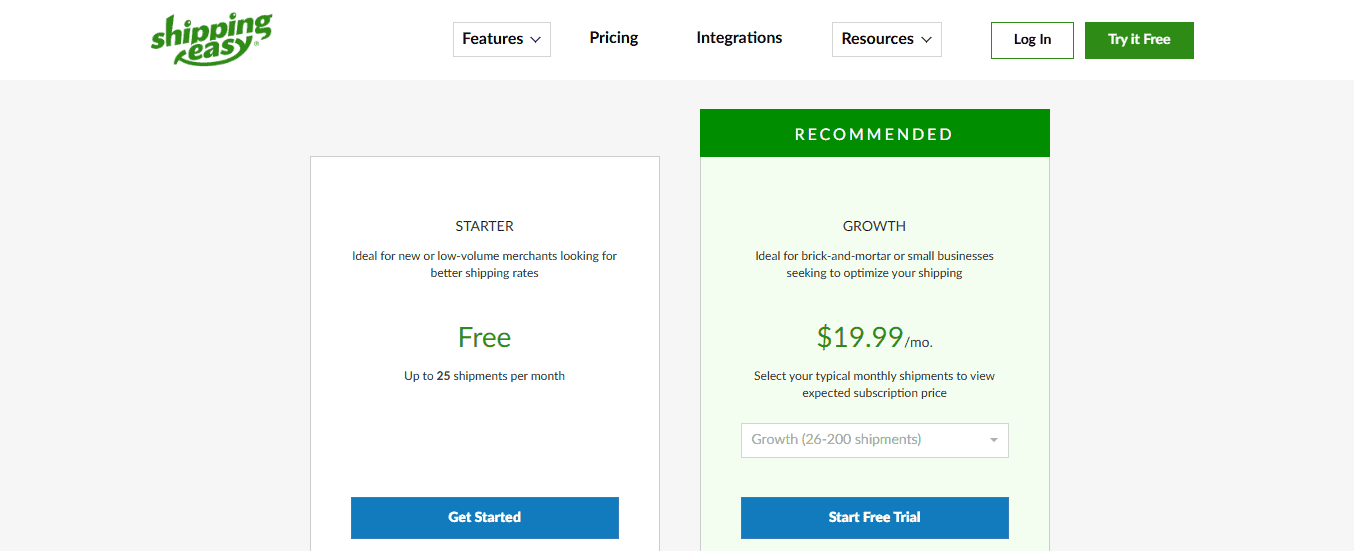
Before you decide: In a world where Amazon promises your target customers same-day delivery for certain orders, these outages can wreak havoc to your bottom line.
#6. ShipBob
ShipBob is one shipping platform that could become your logistics arm. They’ve got over 60 fulfillment centers across the US, UK, and Canada. They enable you to offer same-day and two-day delivery without building warehouses.
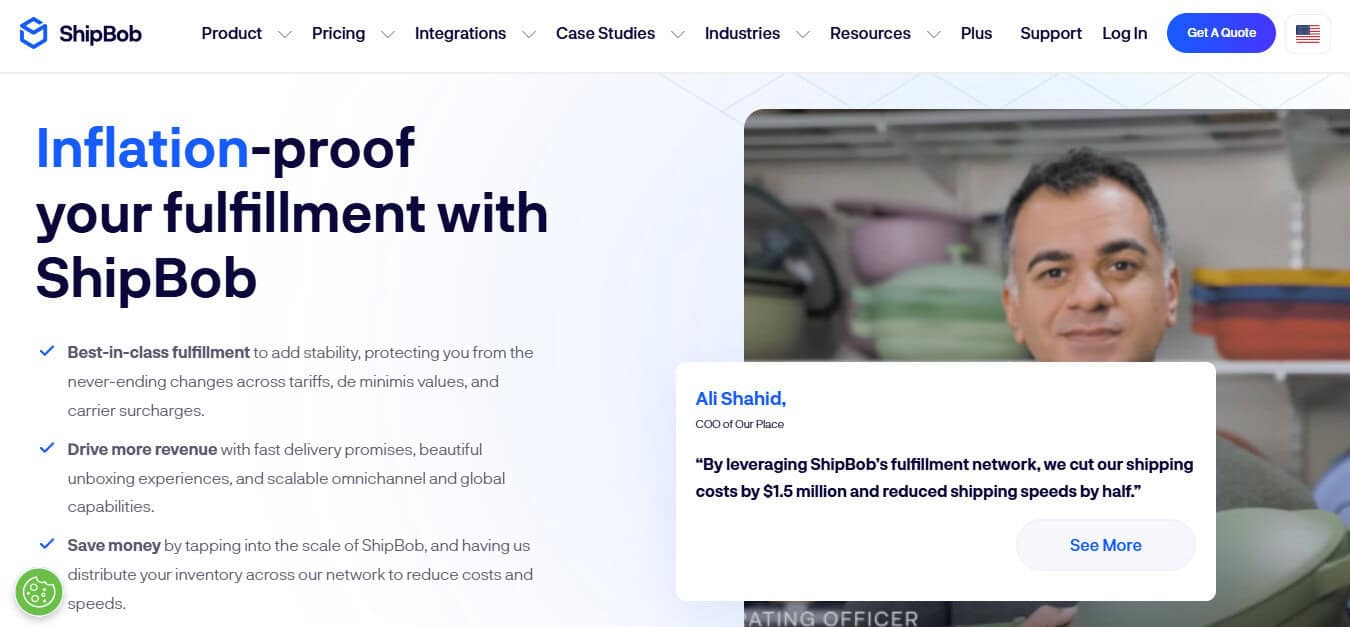
You ship bulk inventory to regional hubs; ShipBob picks, packs, and ships direct to your customers. Transparent per-order and storage fees mean you only pay for the space and labor you use, with no long-term contracts.
Branded unboxing, custom packing slips, inserts, and kitting keep your identity front and center. Smart order routing pushes shipments from the nearest facility. A centralized dashboard delivers real-time inventory, order status, and shipping analytics. International DDP options, B2B EDI workflows, and an API for custom integrations round out the offering.
For hyper-growth brands, “ShipBob Plus” provides dedicated account management and tailored solutions.

Before you decide: For sub-500 monthly orders, ShipBob’s per-order fees and inbound processing costs can outstrip postage savings due to its receiving and storage fees. Customers also complain of no proper packing standards for large orders, which sometimes results in damages ShipBob refuses to take responsibility for, slower-than-advertised shipping times, and poor customer service. And when everything depends on a shipping partner’s timeliness, these lapses can be the difference between a returning customer and one who leaves a negative review on Shopify.
My Take: Why Shippo is the Best Solution for Most eCommerce Stores
Choosing a shipping platform isn’t a one-size-fits-all. It depends on your order volume, geographic spread, automation demands, budget constraints, and brand priorities.
And while each platform shines in its niche, Shippo strikes the best balance for most e-commerce vendors.
It delivers essential building blocks, discounted postage, intuitive automation, branded tracking, and a clean API without upfront commitments or bloat. By aligning cost with use and growth, Shippo ensures you’re never paying for capacity you don’t need.
As you scale, you can confidently layer on more advanced tools or transition to higher-volume tiers, all while knowing your core shipping is handled by a partner whose way of working is rooted in making professional logistics accessible to everyone.
If you’re triggering first shipments or shipping thousands, Shippo’s combination of affordability, capability, and transparency keeps you focused on what matters most: growing your brand, delighting customers, and turning every order into an opportunity for loyalty.
Bottom Line: I personally recommend Shippo as the starting point for most brands, particularly when they’ve outgrown or are frustrated with Shopify Shipping.

